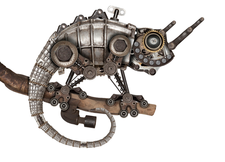Microcontroller programming with BBC micro:bit
Pocket-Size Programming

© Lead Image © Burmakin Andrey, 123rf.com
Designed for students, the BBC micro:bit, in conjunction with MicroPython and the Mu editor, can help you get started with microcontroller programming.
The idea of developing a microcontroller for schools dates back to 2012. In 2016, in cooperation with the University of Lancaster and several dozen industry partners, the British Broadcasting Corporation (BBC) delivered on this concept with the BBC micro:bit [1]. Although developed for seventh grade students, the BBC micro:bit offers an introduction to microcontroller programing for users of any age.
You can purchase the micro:bit individually for $14.95 or as the micro:bit Go Bundle (which includes batteries, a battery holder, and USB cable) for $17.50 from Adafruit [2].
The microcontroller and its components fit on a 5x4cm board (Figure 1). The 32-bit processor, an ARM Cortex-M0, runs at a clock speed of 16MHz. The micro:bit offers 16KB of RAM and a 256KB flash memory. In principle, a Bluetooth Low Energy (BLE) radio is also available. See Table 1 for more specifications.
[...]
Buy this article as PDF
(incl. VAT)
Buy Linux Magazine
Subscribe to our Linux Newsletters
Find Linux and Open Source Jobs
Subscribe to our ADMIN Newsletters
Support Our Work
Linux Magazine content is made possible with support from readers like you. Please consider contributing when you’ve found an article to be beneficial.

News
-
Zorin OS 18 Hits over a Million Downloads
If you doubt Linux isn't gaining popularity, you only have to look at Zorin OS's download numbers.
-
TUXEDO Computers Scraps Snapdragon X1E-Based Laptop
Due to issues with a Snapdragon CPU, TUXEDO Computers has cancelled its plans to release a laptop based on this elite hardware.
-
Debian Unleashes Debian Libre Live
Debian Libre Live keeps your machine free of proprietary software.
-
Valve Announces Pending Release of Steam Machine
Shout it to the heavens: Steam Machine, powered by Linux, is set to arrive in 2026.
-
Happy Birthday, ADMIN Magazine!
ADMIN is celebrating its 15th anniversary with issue #90.
-
Another Linux Malware Discovered
Russian hackers use Hyper-V to hide malware within Linux virtual machines.
-
TUXEDO Computers Announces a New InfinityBook
TUXEDO Computers is at it again with a new InfinityBook that will meet your professional and gaming needs.
-
SUSE Dives into the Agentic AI Pool
SUSE becomes the first open source company to adopt agentic AI with SUSE Enterprise Linux 16.
-
Linux Now Runs Most Windows Games
The latest data shows that nearly 90 percent of Windows games can be played on Linux.
-
Fedora 43 Has Finally Landed
The Fedora Linux developers have announced their latest release, Fedora 43.

